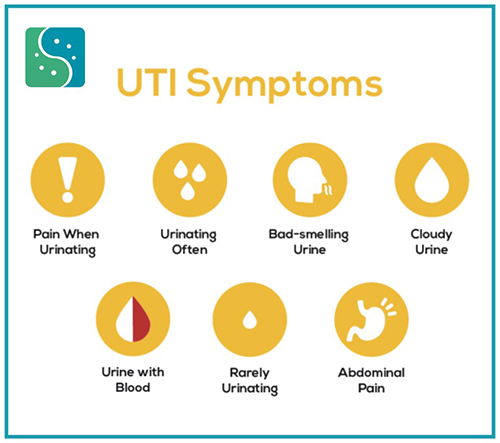URINARY TRACT INFECTION (UTI) is an infection of your urinary system which includes the bladder and kidneys. Symptoms depend on the part of the urinary tract affected by UTI. Bacteria especially E. coli are the most common cause of UTIs. Symptoms include needing to pee often, pain while peeing and pain in your side or lower back.
HOMOEOPATHIC TREATMENT FOR URINARY TRACT INFECTION
Homoeopathy is effective in treating urinary tract infections. The aim of homoeopathy is not only to treat urinary tract infection but to address its underlying cause and individual susceptibility. As far as therapeutic medication is concerned, several well-proved homoeopathic medicines are available for urinary infection treatment and to prevent its recurrence. The medicines are selected based on the homoeopathic principle of individualisation after proper case taking.
KNOW YOUR DISEASE
Urinary tract infection can involve
- Urethra (urethritis)
- Kidneys (pyelonephritis)
- Bladder (cystitis)
SIGNS OF URINARY TRACT INFECTION
A UTI causes inflammation in the lining of your urinary tract. The inflammation may cause the following problems.

- Pain in your flank, abdomen, pelvic area or lower back
- Pressure in the lower part of your pelvis
- Cloudy, foul-smelling pee
- Urinary incontinence
- Frequent urination
- Urge incontinence
- Pain when you pee (dysuria)
- Blood in your pee (hematuria)
Other UTI-associated symptoms may include.
- Pain in your penis
- Feeling extremely tired (fatigue)
- Fever
- Chills
- Nausea and vomiting
- Mental changes or confusion
HOW DO YOU GET A URINARY TRACT INFECTION?
Microorganisms usually bacteria cause urinary tract infections. They typically enter through your urethra and may infect your bladder. The infection can also travel up from your bladder through your ureters and eventually infect your kidneys.
RISK FACTORS
UTIs are common in women. Many women experience more than one UTI during their lifetimes. Risk factors for UTIs that are specific to women include.
- Female anatomy. Women have a shorter urethra than men do. As a result, there's less distance for bacteria to travel to reach the bladder.
- Sexual activity. Being sexually active tends to lead to more UTIs. Having a new sexual partner also increases risk.
- Certain types of birth control. Using diaphragms for birth control may increase the risk of UTIs. Using spermicidal agents also can increase risk.
- Menopause. After menopause, a decline in circulating estrogen causes changes in the urinary tract. The changes can increase the risk of UTIs.
Other risk factors for UTIs include.
- Urinary tract problems. Babies born with problems with their urinary tracts may have trouble urinating. Urine can back up in the urethra, which can cause UTIs.
- Blockages in the urinary tract. Kidney stones or an enlarged prostate can trap urine in the bladder. As a result, risk of UTIs is higher.
- A suppressed immune system. Diabetes and other diseases can impair the immune system, the body's defense against germs. This can increase the risk of UTIs.
- Catheter use. People who can't urinate on their own often must use a tube, called a catheter, to urinate. Using a catheter increases the risk of UTIs. Catheters may be used by people who are in the hospital. They may also be used by people who have neurological problems that make it difficult to control urination or who are paralyzed.
- A recent urinary procedure. Urinary surgery or an exam of your urinary tract that involves medical instruments can both increase the risk of developing a UTI.
HOW ARE URINARY TRACT INFECTIONS DIAGNOSED?
Your doctor will review your medical history and do a physical exam. Other tests may include.
Urinalysis. Lab testing of urine is done to check for various cells and chemicals, such as red and white blood cells, germs (like bacteria), or a lot of protein.
If UTIs become a repeated problem, other tests may be used to see if the urinary tract is normal. These tests may include.
- Intravenous pyelogram (IVP). This is a series of X-rays of the kidney, ureters (the two tubes that connect the kidneys to the bladder), and bladder. It uses a contrast dye injected into a vein. This can be used to find tumors, structural abnormalities, kidney stones, or blockages. It also checks blood flow in the kidneys.
- Cystoscopy. In this test, a thin, flexible tube and viewing device is put in through the urethra to examine the bladder and other parts of the urinary tract. Structural changes or blockages, such as tumors or stones can be found.
- Kidney and bladder ultrasound. This imaging test uses high frequency sound waves to make images of the bladder and the kidneys on a computer screen. The test is used to determine the size and shape of the bladder and the kidneys, and check for a mass, kidney stone(s), cysts, or other blockages or abnormalities.
PREVENTION OF URINARY TRACT INFECTIONS
These steps may help lower the risk of UTIs:
- Drink plenty of liquids, especially water. Drinking water helps dilute the urine. That leads to urinating more often allowing bacteria to be flushed from the urinary tract before an infection can begin.

- Try cranberry juice. Studies that look into whether cranberry juice prevents UTIs aren't final. However, drinking cranberry juice is likely not harmful.
- Wipe from front to back. Do this after urinating and after a bowel movement. It helps prevent the spread of bacteria from the anus to the vagina and urethra.
- Empty your bladder soon after having sex. Also drink a full glass of water to help flush bacteria.
- Avoid potentially irritating feminine products. Using them in the genital area can irritate the urethra. These products include deodorant sprays, douches and powders.
- Change your birth control method. Diaphragms, unlubricated condoms or condoms treated with spermicide can contribute to bacterial growth.
FREQUENTLY ASKED QUESTIONS
A UTI is an infection in your urinary system, which may include your kidneys, ureters, bladder or urethra. Cystitis is a type of UTI. It’s an infection in your bladder, and it’s the most common type of UTI.
If you’re pregnant and have symptoms of a UTI, see your doctor right away.
UTIs during pregnancy can cause high blood pressure and premature delivery. UTIs during pregnancy are also more likely to spread to the kidneys.
UTIs can go away within a week. But if left untreated, UTIs can worsen over time and will need medical attention.
UTIs shouldn’t be left untreated as they can worsen over time. Home remedies like drinking cranberry juice or water may help antibodies clear up the UTI faster.
AN OUTLOOK ON URINARY TRACT INFECTION – BY DR. SMRITI’S HOMOEOPATHIC HEALING
Urinary tract infections are when you have an infection in your urinary system. You may feel embarrassed if you have symptoms that affect your genitals or cause incontinence. Homoeopathic medication not only treats the symptoms of acute urinary tract infection but is also very effective in preventing its recurrence. The medicines are selected on the basis of individualisation and are strongly recommended to treat urinary tract infections.

